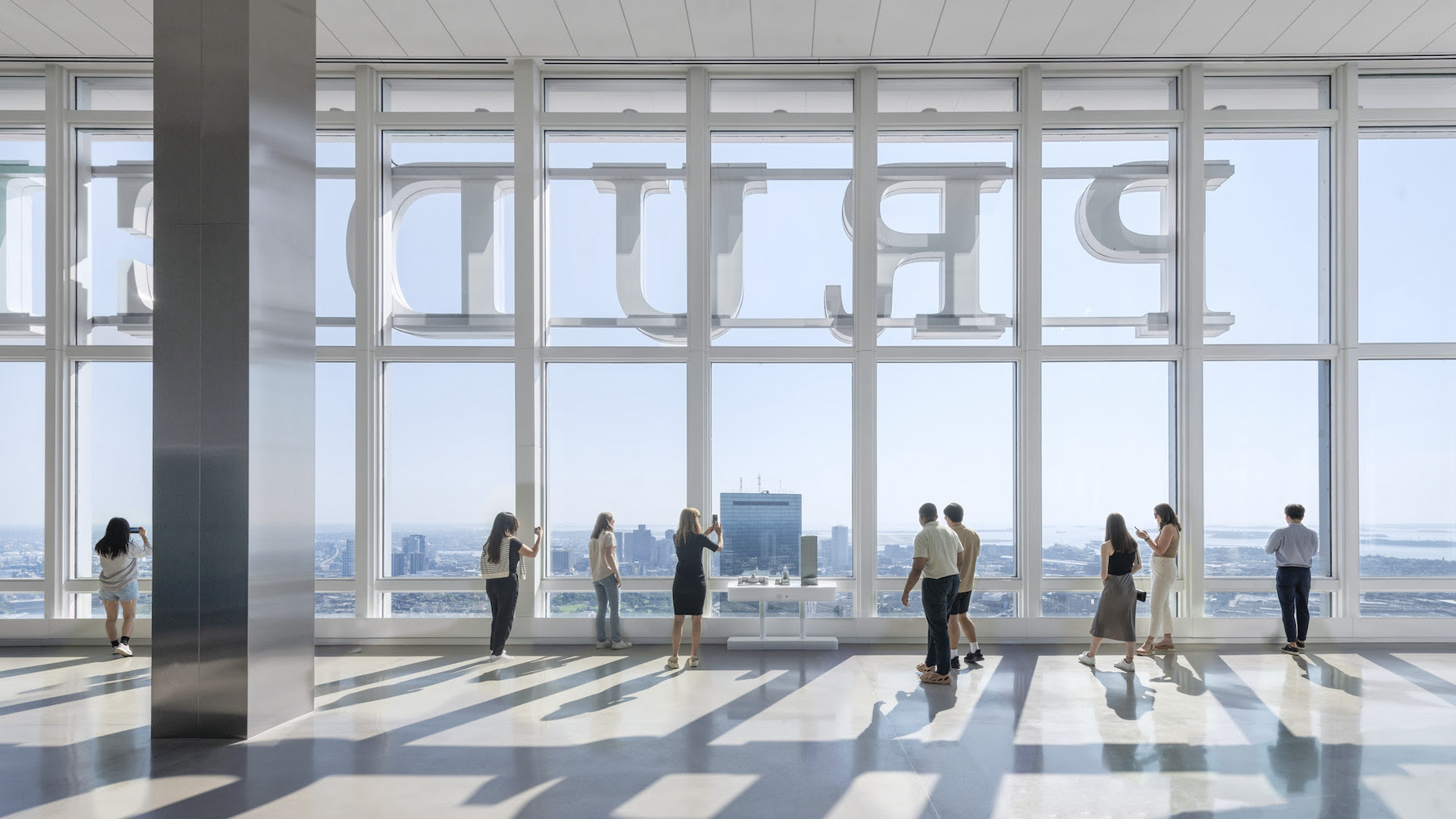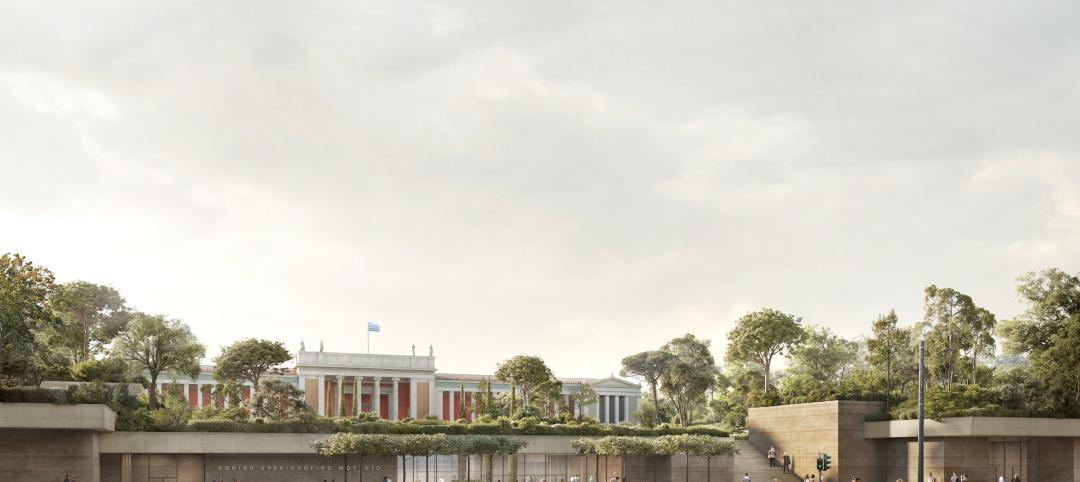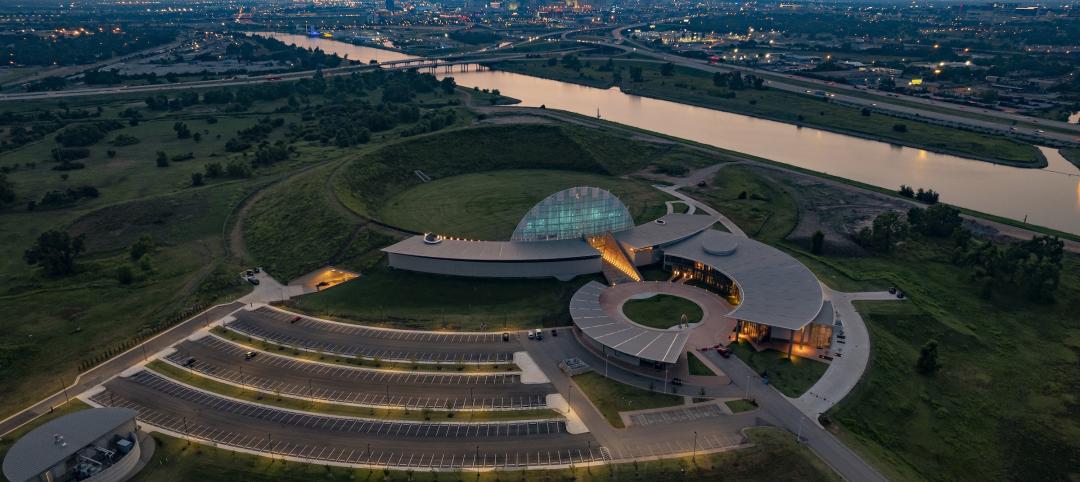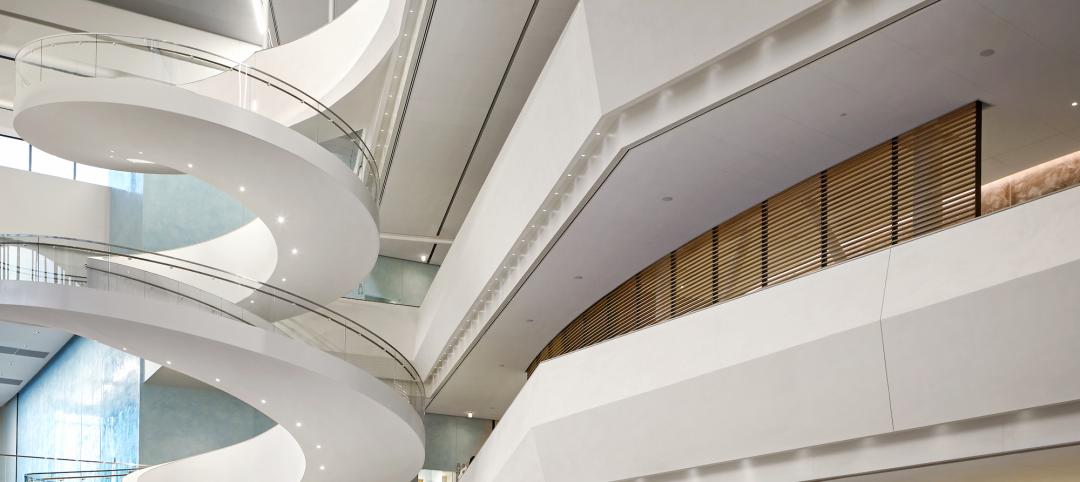Perkins & Will recently released details about and images of View Boston, the three-floor interactive observatory atop the Prudential Tower, which opened for visitors on June 15. P&W’s Boston studio designed the observatory for BXP, the 750-ft-tall building’s owner and the project’s developer.
The observatory provides a panorama of Beantown and its surrounding region. It has its own entrance within the Prudential Center, and elevators with Samsung screens and an interior sound system take visitors to the 52nd floor, named The View, where they can look onto the city vista through the letters of Prudential’s iconic signage.
To create this space, P&W’s team reconfigured the tower’s mechanical system and removed numerous suspended ceilings, walkways, and the solid panel behind the Prudential sign. These upgrades raised the ceiling height to 24 ft, from nine ft, filling the interior wraparound observatory with light.
Guests encounter “specific moments” on tour
The design’s simplicity and minimalism are articulated through a thoughtful placement of windows and doorways, and what P&W calls “a quiet materiality that uses reflectivity and subtle textural cues to guide guests from one episodic experience to the next.” An interior and exterior lighting program, designed in collaboration with LAM Partners, highlights the views and design features of the space.
Matt Pierce, P&W’s Principal who led the design of View Boston, elaborates that visitors encounter “specific moments of interest” as they tour the observatory. Perhaps the most daring allows visitors to step onto the edge of an outdoor roof deck that looks over Boston’s Back Bay neighborhood. The observatory also features an indoor-outdoor bar, a restaurant, and numerous exhibits. Pierce says the architecture supports intuitive wayfinding, as do the observatory’s spaces themselves.
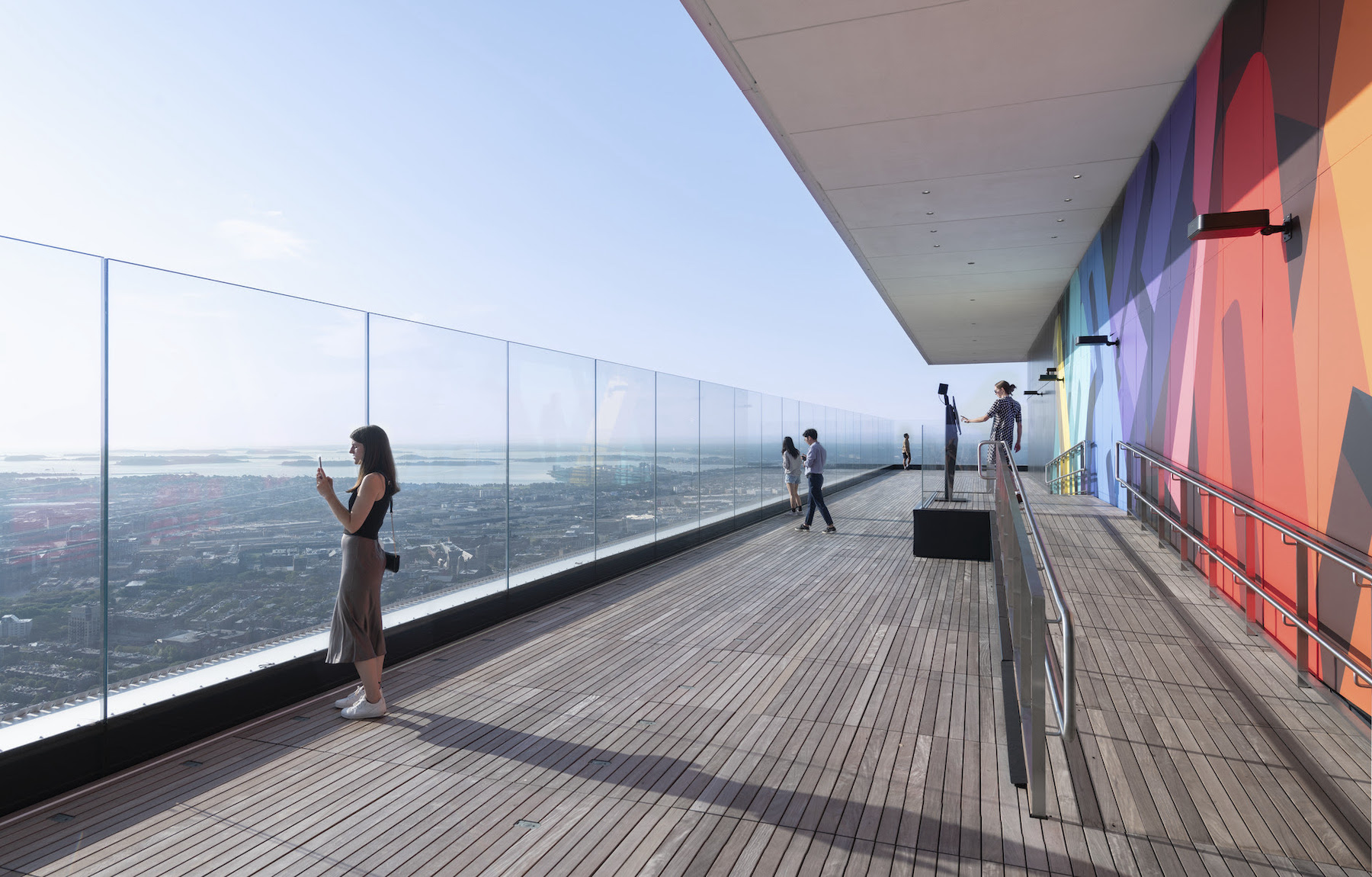
The Pru, which was designed by Charles Luckman & Associates and opened in 1965, has long been an indelible part of Boston’s skyline. But its aging systems required some upgrading to accommodate the addition of the observatory.
An upgrade to the tower’s original mechanical systems allowed BXP and the design teams to reimagine the observatory experience, while elevating the infrastructure to current sustainable, energy efficient standards. Updated cooling systems freed the interior space to house the window washing unit, allowing for the Cloud Terrace—an all-season exterior observation deck and hospitality area on the 51st floor—to take shape where there had been equipment. The installation of a new eight-foot-high frameless glass windscreen makes the outdoor roof deck comfortable and safe while offering a premium viewing experience.
Design features emphasize the view
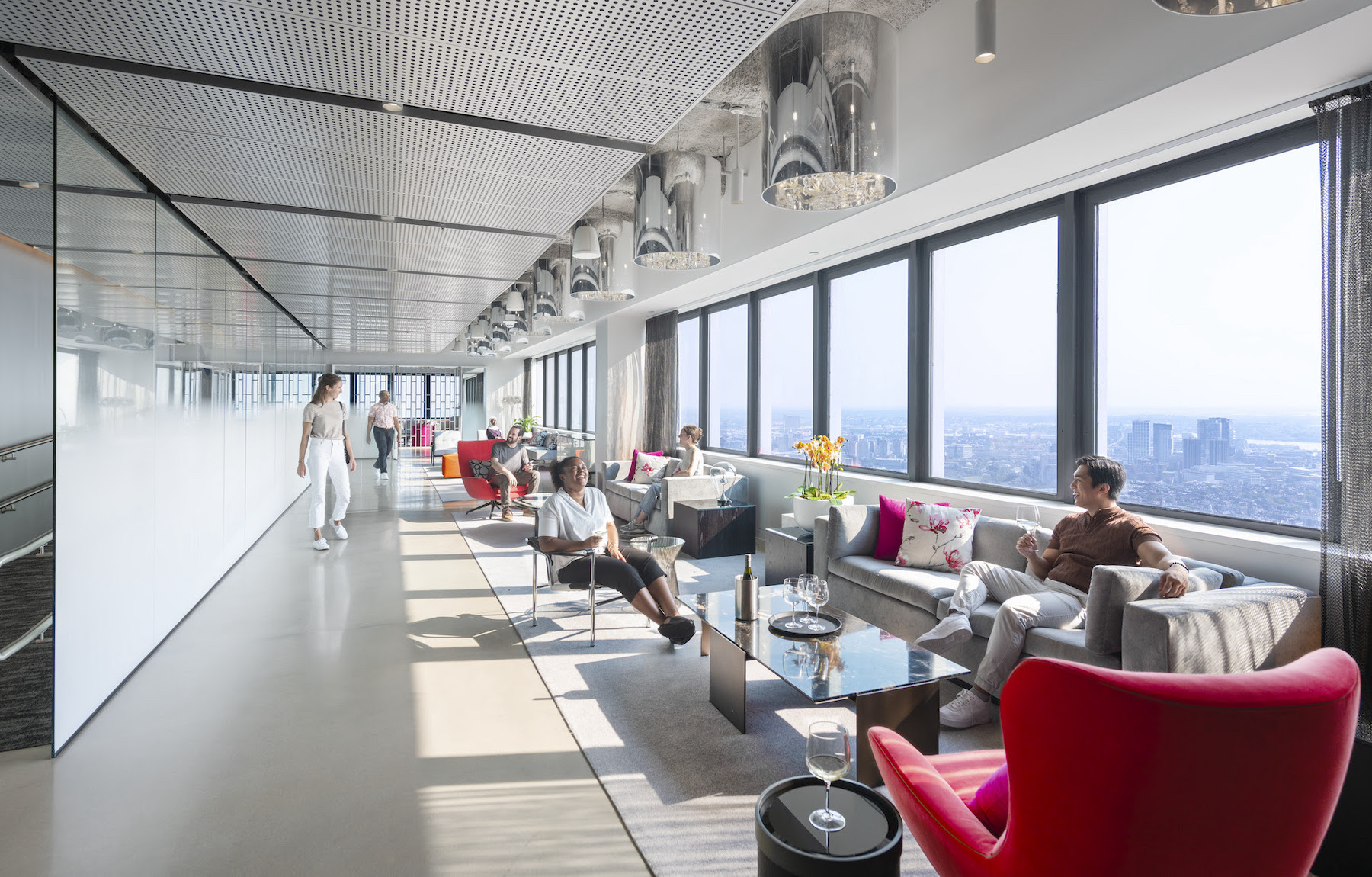
Where possible, materials were chosen sustainably and locally to celebrate Boston’s history: for example, the flooring used in the Stratus cocktail bar on the 51st floor salvaged “Harbor Oak” made from the piers that formerly supported the once-popular Jimmy’s Harborside Restaurant, which was demolished in 2007.
Other design strategies directed attention towards the view. There is an emphasis on glass, both mirrored and transparent. The décor in Stratus references the elements of air and water. The protected interior space flows seamlessly to the exterior seating area and observation deck through movable glass walls that open or close to suit the weather. Additional noteworthy design features include an edge-lit cast glass bar, created by Lucid Glass Studio and a lighting installation by Yellow Goat Design, featuring a reflective metallic canopy of varying heights that in the evening mimics stars in the night sky. Downstairs in The Beacon, the bar faces outwards and is flanked by mirrored columns with custom shelving that reflect the city below.
Working within the existing building limited the ceiling height in the dining area. A high-gloss panel system was designed for this ceiling to reflect light and add a feeling of openness. The floorplans allow for uninterrupted viewing, providing clear sightlines to windows and portals.
The observatory was designed for guest accessibility. Throughout the three stories of attractions, equity is achieved through tactile models of the skyline for guests with vision impairments, native audio systems for hearing support, quiet moments of rest away from the stimulating activity areas, and restaurant and bar seating tailored for easy wheelchair access.
Collaboration between the exhibition design and operations partners proved crucial to achieving the inclusivity goals of the project. (Programming in the exhibition spaces was helmed by JRA, an immersive technology design agency that’s part of RWS Global.)
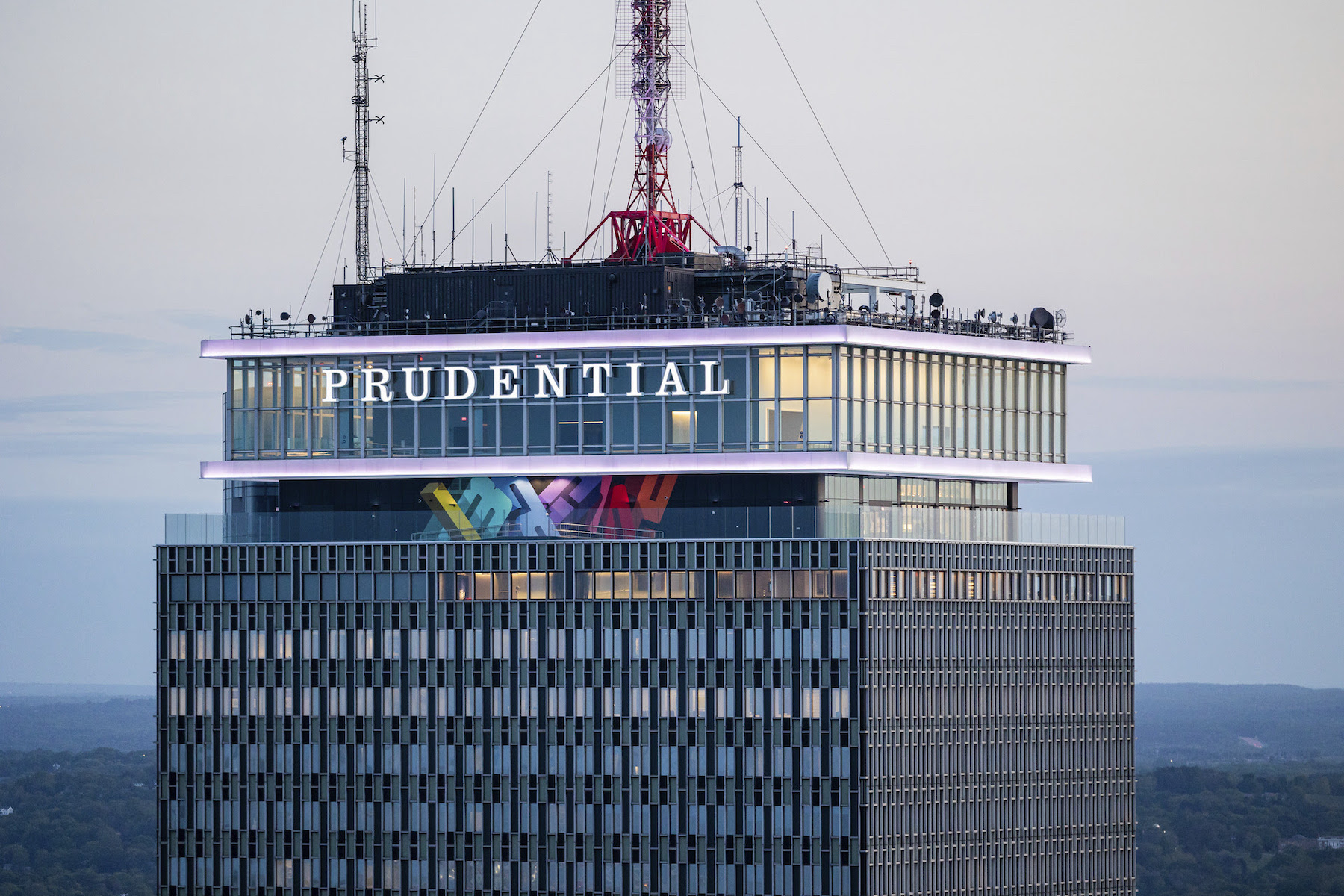
The guest journey throughout the observatory features multiple touchpoints for education and storytelling:
•Boston 365, a 3D model of the city with rotating seasonal display content;
•Virtual Viewers and interactive itinerary-planning touchscreens on the 52nd floor highlighting various cultural and historical landmarks, which the guest can capture via his or her smartphone and form the “ViewPrint” travel guide for the region; and
•The Immersive Theater, a 260-degree theater showcasing the “Open Doors” film that highlights a variety of neighborhoods and attractions.
Related Stories
Libraries | Mar 26, 2023
An abandoned T.J. Maxx is transformed into a new public library in Cincinnati
What was once an abandoned T.J. Maxx store in a shopping center is now a vibrant, inviting public library. The Cincinnati & Hamilton County Public Library (CHPL) has transformed the ghost store into the new Deer Park Library, designed by GBBN.
Performing Arts Centers | Mar 9, 2023
Two performing arts centers expand New York’s cultural cachet
A performing arts center under construction and the adaptive reuse for another center emphasize flexibility.
Libraries | Feb 26, 2023
A $17 million public library in California replaces one that was damaged in a 2010 earthquake
California’s El Centro community, about two hours east of San Diego, recently opened a new $17 million public library. With design by Ferguson Pape Baldwin Architects and engineering services by Latitude 33 Planning & Engineering, the 19,811-sf building replaces the previous library, which was built in the early 1900s, damaged by a 7.2 earthquake that struck Baja California in 2010, and demolished in 2016.
Museums | Feb 22, 2023
David Chipperfield's 'subterranean' design wins competition for National Archaeological Museum in Athens
Berlin-based David Chipperfield Architects was selected as the winner of the design competition for the new National Archaeological Museum in Athens. The project will modernize and expand the original neoclassical museum designed by Ludwig Lange and Ernst Ziller (1866-1874) with new spaces that follow the existing topography of the site. It will add approximately 20,000 sm of space to the existing museum, as well as a rooftop park that will be open to the public.
Museums | Feb 17, 2023
First Americans Museum uses design metaphors of natural elements to honor native worldview
First Americans Museum (FAM) in Oklahoma City honors the 39 tribes in Oklahoma today, reflecting their history through design metaphors of nature’s elements of earth, wind, water, and fire. The design concept includes multiple circles suggested by arcs, reflecting the native tradition of a circular worldview that encompasses the cycle of life, the seasons, and the rotation of the earth.
Giants 400 | Feb 9, 2023
New Giants 400 download: Get the complete at-a-glance 2022 Giants 400 rankings in Excel
See how your architecture, engineering, or construction firm stacks up against the nation's AEC Giants. For more than 45 years, the editors of Building Design+Construction have surveyed the largest AEC firms in the U.S./Canada to create the annual Giants 400 report. This year, a record 519 firms participated in the Giants 400 report. The final report includes 137 rankings across 25 building sectors and specialty categories.
Giants 400 | Feb 6, 2023
2022 Reconstruction Sector Giants: Top architecture, engineering, and construction firms in the U.S. building reconstruction and renovation sector
Gensler, Stantec, IPS, Alfa Tech, STO Building Group, and Turner Construction top BD+C's rankings of the nation's largest reconstruction sector architecture, engineering, and construction firms, as reported in the 2022 Giants 400 Report.
Giants 400 | Feb 6, 2023
2022 Religious Sector Giants: Top architecture, engineering, and construction firms in the U.S. religious facility construction sector
HOK, Parkhill, KPFF, Shawmut Design and Construction, and Wiss, Janney, Elstner head BD+C's rankings of the nation's largest religious facility sector architecture, engineering, and construction firms, as reported in the 2022 Giants 400 Report.
Steel Buildings | Feb 3, 2023
Top 10 structural steel building projects for 2023
A Mies van der Rohe-designed art and architecture school at Indiana University and Morphosis Architects' Orange County Museum of Art in Costa Mesa, Calif., are among 10 projects to win IDEAS² Awards from the American Institute of Steel Construction.
Giants 400 | Feb 1, 2023
2022 Cultural Facilities Giants: Top architecture, engineering, and construction firms in the U.S. cultural facilities sector
Populous, DLR Group, KPFF, Arup, and Turner Construction head BD+C's rankings of the nation's largest cultural facilities sector architecture, engineering, and construction firms, as reported in the 2022 Giants 400 Report. Building types include museums, public libraries, performing arts centers, and concert venues.


